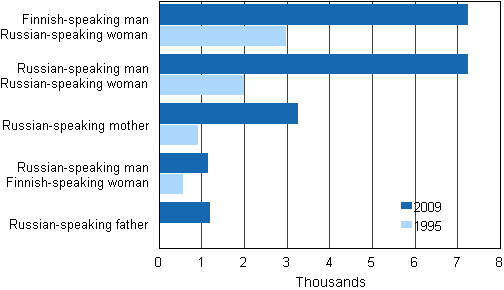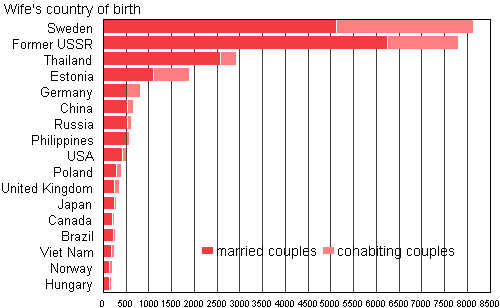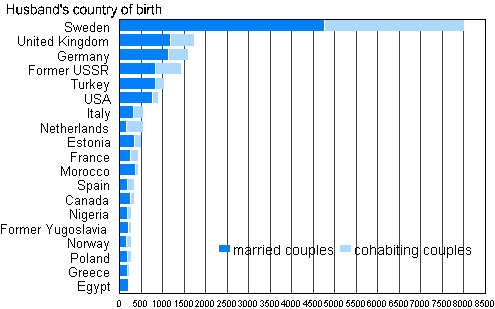2. Only two per cent of families are foreign-language speakers
In 88 per cent of all families the only parent or both parents are Finnish-speakers. Correspondingly, four per cent of families are entirely Swedish-speaking. Families where one spouse is Swedish-speaking and the other Finnish-speaking account for three per cent of all families. Combinations of Finnish and Swedish-speakers with other languages can be found in three per cent of all families. Families where both spouses or the only parent are foreign-language speakers number 35,300, which equals two per cent of all families.
In clearly more cases, Swedish-speaking men have Finnish-speaking spouses than Swedish-speaking women Finnish-speaking spouses. The number of purely Swedish-speaking couples is now just 4,800 higher than that of Finnish and Swedish-speaking couples.
Altogether, 22,000 men who speak Finnish or Swedish as mother tongue are married to or cohabiting with a woman whose mother tongue is a foreign language. The corresponding figure for women is 17,800. Marriages with persons with a foreign native language have increased by slightly under 2,000.
2.1 Speakers of Russian the largest foreign-language group
The number of families where both spouses or the only parent is Russian-speaking is 10,700 and in addition, there are 10,100 families where one of the spouses is Russian-speaking. The number of Russian-speaking families is some 1,000 higher than in the year before. The most common language combination in the Russian-speaking families is one of a Finnish-speaking man and a Russian-speaking woman (Figure 3). In the course of 2009, the number of such couples rose by around 100. Almost equally common are families of Russian-speaking couples. In 1990 Russian-speaking couples numbered 300 and in 1995 around 3,000. Today, as many as nearly 7,300 couples in Finland are Russian-speaking. One-parent families with a Russian-speaking mother already number 3,300.
It is still fairly rare for a Finnish-speaking woman to have a Russian-speaking spouse. However, the number (1,200) has almost quadrupled from 1990 and doubled from 1995.
Figure 3. Russian-speaking families in 1995 and 2009

2.2 Finnish man and foreign wife
In only 4.2 per cent (60,500 families) of all families in Finland at least one of the spouses or the only parent is a foreign citizen. In 1990, such families numbered only 12,500 in Finland but by 1995 the number had already risen to 25,800. In the past year the number has grown by 4,200. The number of families in which both the husband and the wife are foreign nationals grew the most.
Table 4. Families of foreign citizens in 1990–2009
| Man/woman Finnish/foreign | Year | |||||||
| 1990 | 1995 | 2000 | 2005 | 2006 | 2007 | 2008 | 2009 | |
| Finnish man and foreign woman | 3 938 | 7 156 | 10 914 | 15 038 | 16 048 | 17 236 | 18 181 | 19 259 |
| Foreign man and Finnish woman | 6 020 | 8 524 | 10 042 | 13 605 | 14 853 | 15 924 | 17 004 | 17 934 |
| Foreign man and foreign woman | 1 881 | 7 480 | 10 647 | 12 717 | 13 007 | 14 114 | 15 274 | 16 769 |
| Foreign mother | 553 | 2 374 | 3 815 | 4 768 | 5 033 | 5 220 | 5 339 | 5 947 |
| Foreign father | 101 | 300 | 371 | 474 | 498 | 542 | 564 | 628 |
| Total | 12 493 | 25 834 | 35 789 | 46 602 | 49 439 | 53 036 | 56 362 | 60 537 |
In the early 1990s, the most common combination in families of foreign citizens was one where the wife was a Finnish citizen and the husband a foreign citizen. At the end of the 1990s, families where both spouses were foreign citizens were the most numerous. Today, the most common combination in families including a foreign citizen is one where the man is Finnish and the woman a foreign national, and in the second most common combination the man is a foreign national and the wife Finnish. No distinction is made between married and cohabiting couples in these statistics.
Entirely foreign families, i.e. families where the only parent or both spouses are foreign citizens, total 23,300. The largest group among them is composed of the families of Russian citizens. At the end of 2009, there were 5,476 families in Finland where both spouses or the only parent were Russian citizens. The number of families composed of Russian citizens has increased by almost 300.
There were 4,100 entirely Estonian families, of which one-third were families consisting of a mother and children only. The number of Estonian families has grown by nearly 600 from the year before.
Families of two Somali citizens or with one Somali parent numbered slightly under 800. The number of these families has stayed almost unchanged. Many of the Somalis having into Finland in the past have already lived in the country for so long that they have been granted Finnish citizenship. On the basis of mother tongue, there are 1,700 families where both spouses or one parent were originally Somali citizens.
2.3 Foreign-born spouses of women and men from different countries
An examination of countries of birth gives the best picture of the foreign spouses of Finnish nationals. It should, however, be borne in mind that some originally Finnish citizens are also born abroad. Finnish-born men have 31,500 foreign-born wives. The number of foreign-born wives has grown by 1,200 from the previous year.
Finnish-born women have 27,200 foreign-born husbands, whose number has grown by some 900. Today, Finnish men have foreign wives more often than Finnish women have foreign husbands.
The foreign-born spouses of Finnish men and women come from slightly different countries. Men’s foreign-born spouses come mainly from the neighbouring countries, in west, east and south alike. Those born in the area of the former Soviet Union cannot be separated into Russians or Estonians, because even the Estonians' country of birth is mostly the Soviet Union and a large number of the spouses from Estonia had already come to Finland before the collapse of the Soviet Union. Finnish men have 10,400 wives who were born in the former Soviet Union, Russia or Estonia, and 8,200 wives who were born in Sweden. Wives born in Thailand number almost 3,000, and their number has increased by around 400 from last year. Next come spouses born in Germany, China, the Philippines, the USA, Poland and Great Britain.
Women’s foreign-born spouses come from a larger number of countries than men’ spouses. After the 8,000 Swedish-born spouses, the second-largest group of foreign-born spouses of women were those born in the areas of the former Soviet Union. Husbands born in the former Soviet Union, Russia and Estonia number 2,100, which is approximately 100 more than in the year before. The next largest groups of spouses of Finnish women were born in Great Britain, Germany, Turkey and the USA. The total number of countries in which spouses of at least 100 Finnish women were born is 38. The corresponding number for Finnish men is 30.
Figure 4A. Foreign-born spouses of Finnish-born men by country of birth in 2009

Figure 4B. Foreign-born spouses of Finnish-born women by country of birth in 2009

Source: Population and Cause of Death Statistics, Statistics Finland
Inquiries: Marjut Pietiläinen (09) 1734 2798, Timo Nikander (09) 1734 3250, vaesto.tilasto@stat.fi
Director in charge: Jari Tarkoma
Updated 30.11.2010
Official Statistics of Finland (OSF):
Families [e-publication].
ISSN=1798-3231. Annual Review 2009,
2. Only two per cent of families are foreign-language speakers
. Helsinki: Statistics Finland [referred: 19.4.2025].
Access method: http://stat.fi/til/perh/2009/02/perh_2009_02_2010-11-30_kat_002_en.html

